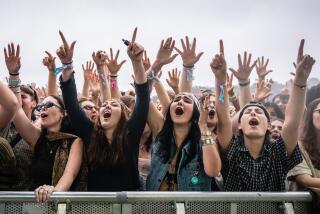Monterey’s Best Plays Out on the Side
MONTEREY, Calif. — The fun of the 39th annual Monterey Jazz Festival, which concluded Sunday night, had a lot less to do with the big picture than it did with the smaller details of the less publicized but more challenging music in its smaller venues.
There was, of course, the usual menu of major names during the three-day event: Joshua Redman, George Benson, Herbie Hancock, Roy Hargrove, the Yellowjackets, Joe Williams, Dianne Reeves and the venerable Jon Hendricks were the showcase acts in the festival’s large arena, the Jimmy Lyons Stage.
But its most intriguing and creative moments emerged in the fringe stages--the Night Club, Dizzy’s Den and the Garden Stage. In these locations, the festival came into focus as a series of small snapshots, a collection of bits and pieces that, in sum, were vastly more fascinating than the feature presentations of the headliners.
The most significant development was the presence of a number of acts who clearly signaled the growing importance of the San Francisco jazz scene. Tenor saxophonists Dave Ellis and Peter Apfelbaum, pianists Jon Jang and Kito Gamble, trumpeter Dimitri Matheny, the ensemble Dogslyde and singers Kitty Margolis and Ann Dyer were among the numerous artists making a convincing case for Bay Area creativity. Ellis and Apfelbaum are exploring the territory between mainstream, avant-garde and alternative jazz; Jang blends traditional Chinese sounds with jazz rhythms; and Dyer is redefining jazz singing with Sheila Jordan as an obvious model.
Other small-venue activity included a virtual clinic in minimalist jazz drumming by Leon Parker in a Columbia jazz jam evening that showcased the bassist Kyle Eastwood’s Quartet and trumpeter Leroy Jones. The eclectic mix of events also featured Howard Johnson’s bass-heavy group, Gravity!, a conversation with Herbie Hancock and invigorating performances by youthful big bands from, among other places, Australia, Japan and New Zealand.
And in two of the festival’s high points, saxophonist Mel Graves and pianist Jessica Williams convincingly demonstrated the kind of world-class talents that should bring them major record label attention.
The major attractions, for the most part, looked to the past: The Carnegie Hall Jazz Orchestra directed by Jon Faddis performed a revival of Lalo Schifrin’s stirring tribute to Dizzy Gillespie, “Gillespiana”; another revival (from 1960), in Hendricks’ “Evolution of the Blues,” featured an especially stirring performance by Joe Williams; the Yellowjackets performed a gospel-oriented piece with the Oakland Youth Chorus; and this year’s specially commissioned work, Cedar Walton’s “Autumn Sketches,” positioned the pianist-composer’s attractive melodies and solid mainstream jazz rhythms within a suite-like orchestral setting.
Beyond the music, the setting alone was, as always, a significant aspect of the festival. The venues were linked by a long, dusty pathway lined with a virtual village of temporary boutiques and eateries. T-shirts, sweat shirts, hats, jewelry, African imports, records, tapes and posters were available in abundance, most of them devoted to jazz themes. At one booth, all-hemp clothes were being sold; at another, a computerized player piano drew crowds of people watching a grand piano playing jazz lines without the aid of human fingers. And, everywhere, there was food--deep-fried turkey and sweet potato pies, spicy Indian specialties, indefinable Cajun combinations and huge, smoking grills filled with barbecuing ribs and hot links.
The best part of the setting, however, was the diverse collection of festival attendees: the little girl doing cartwheels and the tiny pair of towheaded twins dashing across the grass of the Garden Stage arena as the jazz was playing; the Rainbow Lady--a regular at the event--wearing a multicolored caftan, holding a kaleidoscopic umbrella and wielding a blinking wand to offer benedictions to particularly favored performers; the teenagers sitting side by side with graying elders, grooving in unison to the beat.
And, most encouraging of all, there was the multiracial makeup of the crowd. Very nearly an equal mix of whites and African Americans, the Monterey Jazz Festival, with its utterly open amiability and friendship, could have served as an unself-conscious model for social interaction.
More to Read
The biggest entertainment stories
Get our big stories about Hollywood, film, television, music, arts, culture and more right in your inbox as soon as they publish.
You may occasionally receive promotional content from the Los Angeles Times.










